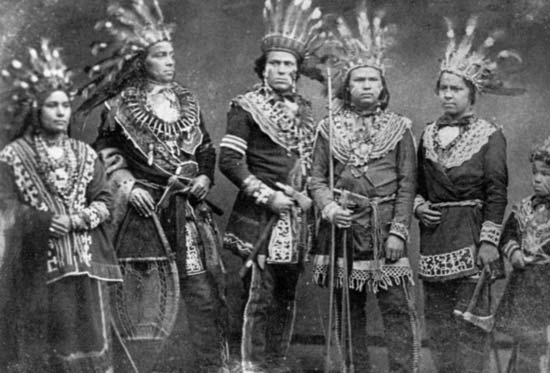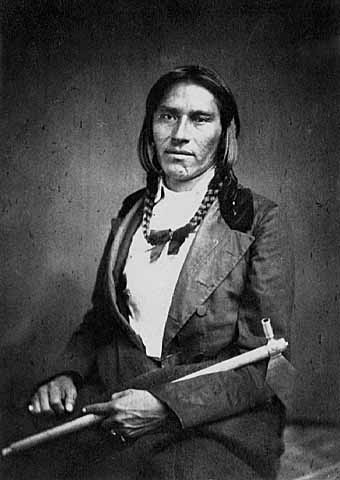|
St. Columba Mission
St. Columba Mission was an Ojibwe community on Gull Lake in Crow Wing County, Minnesota, United States, about north of Fort Ripley. It centered on the first Native American Christian church in the United States west of the Mississippi River, founded in 1852 by the Episcopal missionary James Lloyd Breck and Enmegahbowh, who served as deacon. The squared log church was consecrated in 1853 by Bishop Jackson Kemper. In November 1859, Bishop Henry Benjamin Whipple visited the mission. He wrote that with an interpreter they "held a sweet service in the log church of St. Columba on the banks of the loveliest of Minnesota lakes" and dedicated a cemetery. The village that grew up around the mission included a school and a store. All of it was burned to the ground in the Dakota War of 1862, after which the mission moved to the White Earth Indian Reservation. No visible trace of the settlement remains at the Gull Lake site, but it is listed on the National Register of Historic Places ... [...More Info...] [...Related Items...] OR: [Wikipedia] [Google] [Baidu] |
Ojibwe
The Ojibwe, Ojibwa, Chippewa, or Saulteaux are an Anishinaabe people in what is currently southern Canada, the northern Midwestern United States, and Northern Plains. According to the U.S. census, in the United States Ojibwe people are one of the largest tribal populations among Native Americans in the United States, Native American peoples. In Canada, they are the second-largest First Nations in Canada, First Nations population, surpassed only by the Cree. They are one of the most numerous Indigenous peoples of the Americas, Indigenous Peoples north of the Rio Grande. The Ojibwe population is approximately 320,000 people, with 170,742 living in the United States , and approximately 160,000 living in Canada. In the United States, there are 77,940 mainline Ojibwe; 76,760 Saulteaux; and 8,770 Mississauga, organized in 125 bands. In Canada, they live from western Quebec to eastern British Columbia. The Ojibwe language is Ojibwe language, Anishinaabemowin, a branch of the Algonquia ... [...More Info...] [...Related Items...] OR: [Wikipedia] [Google] [Baidu] |
The Living Church
''The Living Church'' is a magazine based in Milwaukee, Wisconsin, providing commentary and news on the Episcopal Church and the wider Anglican Communion. In continuous publication since 1878, it has generally been identified with the Anglo-Catholic wing of Anglicanism, and has been cited by national newspapers as a representative of that party. It absorbed a number of earlier Anglo-Catholic publications, including ''The American Churchman'', ''Catholic Champion'' (1901), and ''The Angelus'' (1904). Theologically and culturally, it tends to have a moderate-to-conservative slant. On June 21, 1931, the last issues of associated periodicals, ''The Young Churchman'' and ''The Shepherd's Arms'' were published. The editor of ''The Living Church'' is Mark Michael. The periodical is a member of the Associated Church Press, a religious periodical group. Some of the magazine's content has been made available online since the late 20th century. Editors * Samuel Smith Harris (1878–1879) ... [...More Info...] [...Related Items...] OR: [Wikipedia] [Google] [Baidu] |
Episcopal Church Buildings In Minnesota
Episcopal may refer to: *Of or relating to a bishop, an overseer in the Christian church *Episcopate, the see of a bishop – a diocese *Episcopal Church (other), any church with "Episcopal" in its name ** Episcopal Church (United States), an affiliate of Anglicanism based in the United States *Episcopal conference, an official assembly of bishops in a territory of the Roman Catholic Church *Episcopal polity, the church united under the oversight of bishops * Episcopal see, the official seat of a bishop, often applied to the area over which he exercises authority *Historical episcopate, dioceses established according to apostolic succession See also * Episcopal High School (other) * Pontifical (other) The Pontifical is a liturgical book used by a bishop. It may also refer specifically to the Roman Rite Roman Pontifical. When used as an adjective, Pontifical may be used to describe things related to the office of a Bishop (see also Pontiff#Chris ...< ... [...More Info...] [...Related Items...] OR: [Wikipedia] [Google] [Baidu] |
Demolished Buildings And Structures In Minnesota
Demolition (also known as razing, cartage, and wrecking) is the science and engineering in safely and efficiently tearing down of buildings and other artificial structures. Demolition contrasts with deconstruction, which involves taking a building apart while carefully preserving valuable elements for reuse purposes. For small buildings, such as houses, that are only two or three stories high, demolition is a rather simple process. The building is pulled down either manually or mechanically using large hydraulic equipment: elevated work platforms, cranes, excavators or bulldozers. Larger buildings may require the use of a wrecking ball, a heavy weight on a cable that is swung by a crane into the side of the buildings. Wrecking balls are especially effective against masonry, but are less easily controlled and often less efficient than other methods. Newer methods may use rotational hydraulic shears and silenced rock-breakers attached to excavators to cut or break through woo ... [...More Info...] [...Related Items...] OR: [Wikipedia] [Google] [Baidu] |
Buildings And Structures In Crow Wing County, Minnesota
A building, or edifice, is an enclosed structure with a roof and walls standing more or less permanently in one place, such as a house or factory (although there's also portable buildings). Buildings come in a variety of sizes, shapes, and functions, and have been adapted throughout history for a wide number of factors, from building materials available, to weather conditions, land prices, ground conditions, specific uses, prestige, and aesthetic reasons. To better understand the term ''building'' compare the list of nonbuilding structures. Buildings serve several societal needs – primarily as shelter from weather, security, living space, privacy, to store belongings, and to comfortably live and work. A building as a shelter represents a physical division of the human habitat (a place of comfort and safety) and the ''outside'' (a place that at times may be harsh and harmful). Ever since the first cave paintings, buildings have also become objects or canvasses of much artist ... [...More Info...] [...Related Items...] OR: [Wikipedia] [Google] [Baidu] |
Archaeological Sites On The National Register Of Historic Places In Minnesota
Archaeology or archeology is the scientific study of human activity through the recovery and analysis of material culture. The archaeological record consists of artifacts, architecture, biofacts or ecofacts, sites, and cultural landscapes. Archaeology can be considered both a social science and a branch of the humanities. It is usually considered an independent academic discipline, but may also be classified as part of anthropology (in North America – the four-field approach), history or geography. Archaeologists study human prehistory and history, from the development of the first stone tools at Lomekwi in East Africa 3.3 million years ago up until recent decades. Archaeology is distinct from palaeontology, which is the study of fossil remains. Archaeology is particularly important for learning about prehistoric societies, for which, by definition, there are no written records. Prehistory includes over 99% of the human past, from the Paleolithic until the advent of ... [...More Info...] [...Related Items...] OR: [Wikipedia] [Google] [Baidu] |
1862 Disestablishments In Minnesota
Year 186 ( CLXXXVI) was a common year starting on Saturday (link will display the full calendar) of the Julian calendar. At the time, it was known as the Year of the Consulship of Aurelius and Glabrio (or, less frequently, year 939 ''Ab urbe condita''). The denomination 186 for this year has been used since the early medieval period, when the Anno Domini calendar era became the prevalent method in Europe for naming years. Events By place Roman Empire * Peasants in Gaul stage an anti-tax uprising under Maternus. * Roman governor Pertinax escapes an assassination attempt, by British usurpers. New Zealand * The Hatepe volcanic eruption extends Lake Taupō and makes skies red across the world. However, recent radiocarbon dating by R. Sparks has put the date at 233 AD ± 13 (95% confidence). Births * Ma Liang, Chinese official of the Shu Han state (d. 222) Deaths * April 21 – Apollonius the Apologist, Christian martyr * Bian Zhang, Chinese official and g ... [...More Info...] [...Related Items...] OR: [Wikipedia] [Google] [Baidu] |
1853 Establishments In Minnesota Territory
Events January–March * January 6 – Florida Governor Thomas Brown signs legislation that provides public support for the new East Florida Seminary, leading to the establishment of the University of Florida. * January 8 – Taiping Rebellion: Zeng Guofan is ordered to assist the governor of Hunan in organising a militia force to search for local bandits. * January 12 – Taiping Rebellion: The Taiping army occupies Wuchang. * January 19 – Giuseppe Verdi's opera ''Il Trovatore'' premieres in performance at Teatro Apollo in Rome. * February 10 – Taiping Rebellion: Taiping forces assemble at Hanyang, Hankou, and Wuchang, for the march on Nanjing. * February 12 – The city of Puerto Montt is founded in the Reloncaví Sound, Chile. * February 22 – Washington University in St. Louis is founded as Eliot Seminary. * March – The clothing company Levi Strauss & Co. is founded in the United States. * March 4 – Inauguration of Franklin Pierce as 14th President of the ... [...More Info...] [...Related Items...] OR: [Wikipedia] [Google] [Baidu] |
Hole-In-The-Day
Hole in the Sky (The Younger) (1825–1868) was a prominent chief of the Ojibwe, Native Americans of Minnesota. The Ojibwe pronunciation has been written in various spellings such as Bagone-giizhig, Bagwunagijik, Bug-o-nay-ki-shig, Pugonakeshig or Puk-O-Nay-Keshig. Hole-in-the-Sky has also been called Hole-in-the-Day. The name refers to a dream in which the guardian spirit was seen through an opening in the clouds. It also refers to the Anishinaabek name for the constellation of the same name, also known as the Pleiades. Biography In 1847 Hole in the Day (the Younger) succeeded his father, Hole in the Day (the Elder), as head chief of the Mississippi Band of the Ojibwe in central Minnesota. Like his father, Hole in the Day the Younger was prominent in skirmishes against the Dakota people, and was prominent in negotiations with the Dakota and with the U.S. government. Hole in the Day the Younger strove to be considered the head chief of all Minnesota Ojibwe. Most white governme ... [...More Info...] [...Related Items...] OR: [Wikipedia] [Google] [Baidu] |
Brainerd, Minnesota
Brainerd is a city in Crow Wing County, Minnesota, United States. Its population was 14,395 at the 2020 census. It is the county seat of Crow Wing County. Brainerd straddles the Mississippi River several miles upstream from its confluence with the Crow Wing River, having been founded as a site for a railroad crossing above the confluence. Brainerd is the principal city of the Brainerd Micropolitan Area, a micropolitan area covering Cass and Crow Wing counties and with a combined population of 96,189 at the 2020 census. The city is well known for being the partial setting of the 1996 film ''Fargo''. History The area that is now Brainerd was formerly Ojibwe territory. Brainerd was first seen by European settlers on Christmas Day in 1805, when Zebulon Pike stopped there while searching for the headwaters of the Mississippi River. Crow Wing Village, a fur and logging community near Fort Ripley, brought settlers to the area in the mid-19th century. In those early year ... [...More Info...] [...Related Items...] OR: [Wikipedia] [Google] [Baidu] |
Brainerd Daily Dispatch
The ''Brainerd Dispatch'' is a daily morning newspaper published in Brainerd, Minnesota. The newspaper was founded on December 22, 1881, and became a daily paper in 1883. In April 2004, the Dispatch became a morning paper. In July 2020, the publication switched to twice-a-week printing and delivery. The paper is owned by Forum Communications. The paper is published by Pete Mohs. History The paper was formerly owned by Stauffer Communications, which was acquired by Morris Communications in 1994. On December 26, 2013, Fargo, North Dakota based Forum Communications Company entered a deal with Morris to purchase several newspaper properties owned by Morris Communications including the ''Brainerd Dispatch''. The deal was set to be finalized on January 1, 2014. On July 16, 2020, the Brainerd Dispatch newspaper did not roll off its printing presses for the first time in 137 years but was instead available to readers in a digital format. The printed paper continued its delivery Wedn ... [...More Info...] [...Related Items...] OR: [Wikipedia] [Google] [Baidu] |
Minnesota State Highway 371
Minnesota State Highway 371 (MN 371) is a highway in central and north-central Minnesota. The route connects Minnesota's northern lakes region with the central part of the state. It runs south–north from U.S. Highway 10 (US 10) in Little Falls to US 2 in Cass Lake. MN 371 has become a heavily traveled arterial route that was once a two-lane roadway over almost all of its length, but has been widened to four lanes across most of its southern half. Much of the traffic utilizing the route is Twin Cities-based traffic heading to their cabins on one of the many northern lakes. Route description MN 371 serves as a south–north route in central and north-central Minnesota between Little Falls, Baxter, Brainerd, Nisswa, Pequot Lakes, Walker, and Cass Lake. Highway 371 departs from US 10 at Little Falls heading to the north, paralleling the Mississippi River on the east side of the river. MN 371 is a freeway-standard route coming ... [...More Info...] [...Related Items...] OR: [Wikipedia] [Google] [Baidu] |



.jpg)



